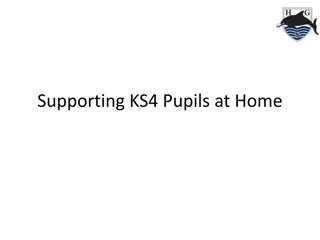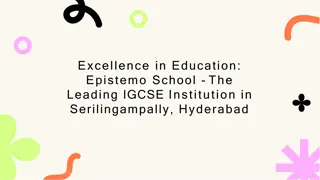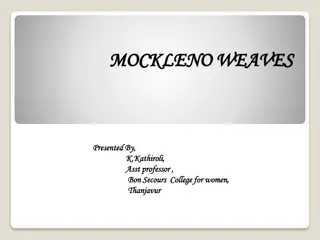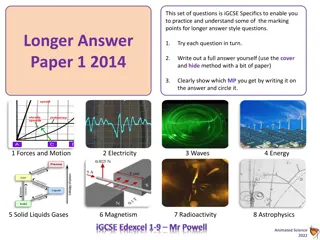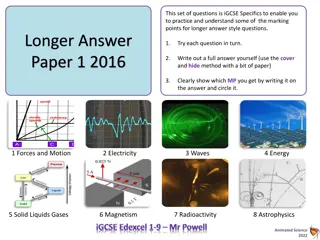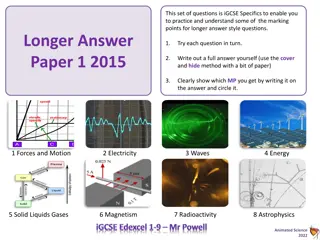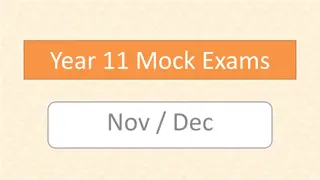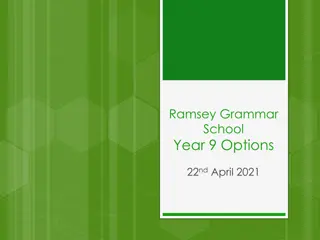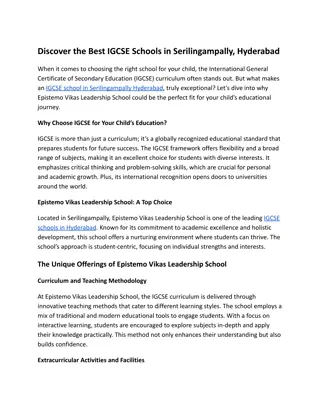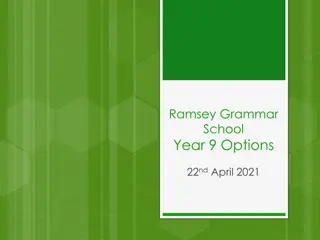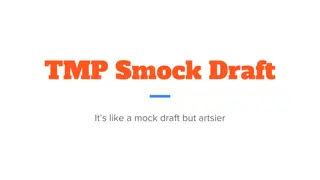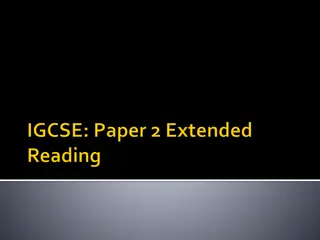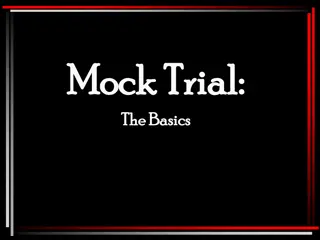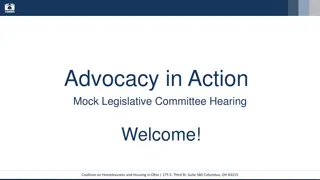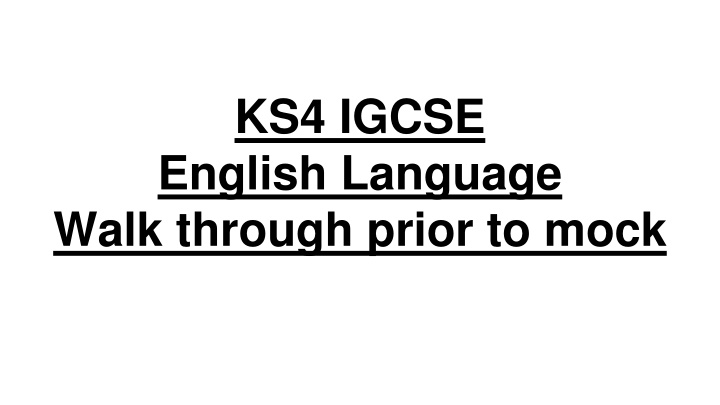
Mastering IGCSE English Language Writing Section Strategies
Enhance your IGCSE English Language writing skills with a detailed walk-through of the writing section, covering key elements such as punctuation, sentence structures, linguistic techniques, text shaping, and more. Prepare effectively for your mock exams in just 45 minutes!
Download Presentation

Please find below an Image/Link to download the presentation.
The content on the website is provided AS IS for your information and personal use only. It may not be sold, licensed, or shared on other websites without obtaining consent from the author. If you encounter any issues during the download, it is possible that the publisher has removed the file from their server.
You are allowed to download the files provided on this website for personal or commercial use, subject to the condition that they are used lawfully. All files are the property of their respective owners.
The content on the website is provided AS IS for your information and personal use only. It may not be sold, licensed, or shared on other websites without obtaining consent from the author.
E N D
Presentation Transcript
KS4 IGCSE English Language Walk through prior to mock
Start with the writing section - MAX 45 mins! Time yourself
Level 5 Flair Shape All of the stuff to the right .LOTS Level 3 Accurate Punctuation: full stops, capital letters, question mark, exclamation mark, speech marks, commas in a list Sentence structures: simple sentences. compound sentences Text shape: paragraphed Tone: straightforward but a good command of the English Language Text type: clear sense of text type Level 4 Variety Punctuation: Commas to mark clauses, Colons to introduce lists, explanations and speech, semi-colons for two independent but related clauses, dashes lots of dashes, brackets, ellipsis, inverted commas Sentence variety: short sentences, one word sentences, multi-clause sentences, ISPACED (-ing starts, simile starts, prepositional started, adverbial starts, connective starts, -ed starts) A unique perspective / a hugely creative approach to the task. Linguistic techniques: Tricolons, emotive words, anecdote, statistics, quote from a reliable source, repetition, contrasts Anecdote flip anecdote Text shape: short paragraphs, long paragraphs, one sentence paragraph, sub-headings, headings, bullet points, box for a graph or an image Cyclical structure Tone: A shifting or contrasting tone / appeal to ethos, pathos, logos Text type: Consistent embedding of key features
Newspaper Heading Sub-heading/s Quotes from the article Photo Caption of the photo Paragraphing Letter Speech Guidebook Heading Pictures and captions Introductory paragraph Sub-headings and sections that tackle different aspects Quotations Address Date Short first paragraph Dear .. Yours sincerely / faithfully plus name First person Title Short paragraphs one sentence paragraphs (either using imperatives or anaphora) Mixture pgh lengths First person Time reference, Today Bullet points anaphora Sub-headings Direct address to the audience
Introducing SADOC to help you plan a response S Spider leg A Add detail What is the main idea you wish to convey? How will you develop this idea? What details could you add? What devices will you use to engage with your reader? Where will this appear within your writing? Where does it fit in the order of your piece? What connective or adverbial could you use to start this section of writing? D Device O Order C Connective or adverbial
Question 1: 2 marks: 5 mins Steps 1. Open the question booklet. 2. Identify the line reference 3. Box out the lines 4. Read question tag 5. Highlight all relevant information 6. Choose two most relevant / most significant to transfer across
Question 2: 4 marks: 5-7 minutes Steps 1. Identify the line reference 2. Box out the lines 3. Read question tag 4. Highlight all relevant information 5. Go back through your highlights. In the margin, mark your inference using synonyms. 6. Transfer these across to your paper. a. Firstly, the writer thinks/feels because b. Secondly, the writer thinks/feels because c. Up to Sixthly to capture 4 marks. Do not use quotations.
Question 3: 5 marks: 7-10 minutes Steps 1. You may use quotations really means you MUST use quotations 2. Identify the line reference 3. Box out the lines 4. Read question tag 5. Highlight all relevant information 6. Go back through your highlights. In the margin, mark your inference using synonyms. 7. Use the structure of INFERENCE and SUPPORTING QUOTATION a. Initially, the writer wonders if the penguins are actually alive. He states that perhaps they are just resting or recovering . Make 4 points well or 5 to capture.
Question 4: 12 marks: 25 minutes MAXIMUM Steps 1. Always a language and structure question on ANTHOLOGY text 2. Identify question stem. 3. Highlight everything of relevance. 4. Go back through - left margin - techniques used, right margin - inference, implication. 5. Ensure you have a range from across the text - At the start of the extract , In the middle of the extract , Towards the end of the extract 6. Transfer onto paper using WHAT HOW WHY structure a. WHAT technique (you need to have at least one reference for lang / structure) b. HOW - quotation c. WHY - inference / implication in relation to the question - use the key words from the question. 7. Aim for 6 WHW (poss 8) from across the extract.
Examples Onomatopoeia is used at the start of the extract to generate interest and excitement when the writer states that there was A sudden thump which creates a sense of immediacy and anticipation about the removal of the hawk from the box. The use of the adverb sudden also generates interest and excitement as it implies the bird is making exaggerated movements quickly, building up the suspense of its release. In the middle of the extract, repetition is used to emphasise the size of the hawk and generate interest and excitement. The writer reveals that the hawk is enormous and in repeating this adjective, we can see that this impacts upon the writer and creates a sense of awe / fear because of the size of the bird.
Question 5: 22 marks: 40 minutes - if you want a 7-9 this is where you need to get to Steps 1. Introduction - easy to gain 8 marks with one pgh of introduction Identify text type for Text A and Text B Identify person extract is written in Identify initial response to question tag - what is text about in relation to question - what is experience in each text? Identify tone potentially - factual, narrative
H is for Hawk introduction example Both Text A An Unexpected Meeting and Text B H is for Hawk are about the reactions writers have to birds - penguins in Text A and hawks in Text B. Both texts are written in the form of a memoir using the first person to explore their response and reactions to these birds. Whilst Text A is focused on the rescue of a penguin - a chance meeting, Text B explores the writer choosing a hawk that will ultimately help to rescue her.
Question 5: 22 marks: 40 minutes MAXIMUM Steps 1. Bash intro out with those key details quickly - guarantee 8 marks. 2. Re-read Text A with question focus in mind. Track each paragraph in relation to question. Note down brief summation in relation to question. 3. Go back to Text B - do the same but connect as you are reading through. 4. Identify comparative points in terms of strength 5. Turn paragraphs into WHAT HOW WHY pghs using comparative connectives. 6. Write as many as you can in the time you have remaining.
If you fail to plan, plan to fail! Text A - experiences Text B - experiences Re-read Text A and identify experiences Track each pgh and key ideas being presented. Write a quick summation in margin 1. 2. 3. 4. 5. 6. 7. 8. 9. Description of harbour Captivated by penguins Seashore covered in dead birds - shock Single bird alive - wonder Confronting the bird - angry bird Wanting to help - clean Captured the bird - using stuff from the beach Angry creature Fear of bird in taking bird back to apartment - hurting it but also being hurt
If you fail to plan, plan to fail! Text A - experiences Text B - experiences Re-read Text A and identify experiences Track each pgh and key ideas being presented. Write a quick summation in margin 1. 2. Starts in middle of action Sudden noise of bird. Reflection of how fearful they appear to bird. Connect to point 9 Text A Angry bird - connect to point 5 Text A Description of bird - mythological - connect to point 7 ref Achilles Text A Appearance of bird - connect to point 3 Text A Reaction of man - calm - connect to point 3 / 9 Text A 2nd hawk - description connect to point 3, 7 Text A Wants to change bird - connect to point 9 taking bird home Ends on cliffhanger - connect to point 9 what happens 3. 4. 1. 2. 3. Description of harbour Captivated by penguins Seashore covered in dead birds appearance- shock Single bird alive - wonder Confronting the bird - angry bird Wanting to help - clean Captured the bird - using stuff from the beach - brave Angry creature Fear of bird in taking bird back to apartment - hurting it but also being hurt 5. 6. 4. 5. 6. 7. 7. 8. 8. 9. 9.
Exemplar paragraph Whilst Text A starts with a calm description of the setting, Text B starts in the middle of the action. We learn that Text A is set in a harbour which is described as small, sufficient only for a few score fishing boats and pleasure craft, which on that day were rocking gently on their moorings. The impression we get of this setting is calm, somewhat isolated and peaceful which is reinforced by the use of the adjective small and few to describe the size of the harbour and the number of boats that can be seen. Furthermore, the boats are described using the verb phrase rocking gently to emphasise the stillness of the day so we cannot anticipate the drama that is about to unfold. This is in direct contrast to Text B, which starts in the middle of the action and the arrival of a hawk with a sudden thump. Unlike Text A, strong movements and sounds are made by the hawk to signal its arrival. The verb thump is a hardened, somewhat aggressive action and the adverb sudden suggests an unanticipated movement. This is in direct contrast to the boats rocking gently on the harbour. Moreover, when the hawk is described in the dialogue as having her hood off , an element of tension is created as the hood keeps the hawk from fearful sights so calms them down. This knowledge shared by the writer implies that the scene is quite fraught because the hawk, itself, is feeling fraught in her box. The tension, therefore, in Text B is immediate from the start.
Exemplar paragraph Whilst Text A starts with a calm description of the setting, Text B starts in the middle of the action. We learn that Text A is set in a harbour which is described as small, sufficient only for a few score fishing boats and pleasure craft, which on that day were rocking gently on their moorings. The impression we get of this setting is calm, somewhat isolated and peaceful which is reinforced by the use of the adjective small and few to describe the size of the harbour and the number of boats that can be seen. Furthermore, the boats are described using the verb phrase rocking gently to emphasise the stillness of the day so we cannot anticipate the drama that is about to unfold. This is in direct contrast to Text B, which starts in the middle of the action and the arrival of a hawk with a sudden thump. Unlike Text A, strong movements and sounds are made by the hawk to signal its arrival. The verb thump is a hardened, somewhat aggressive action and the adverb sudden suggests an unanticipated movement. This is in direct contrast to the boats rocking gently on the harbour. Moreover, when the hawk is described in the dialogue as having her hood off , an element of tension is created as the hood keeps the hawk from fearful sights so calms them down. This knowledge shared by the writer implies that the scene is quite fraught because the hawk, itself, is feeling fraught in her box. The tension, therefore, in Text B is immediate from the start. Comparative connective Topic sentence Textual reference Techniques Inference / Implication Building connective
If you fail to plan, plan to fail! Text A - experiences Text B - experiences Re-read Text A and identify experiences Track each pgh and key ideas being presented. Write a quick summation in margin 1. 2. Starts in middle of action Sudden noise of bird. Reflection of how fearful they appear to bird. Connect to point 9 Text A Angry bird - connect to point 5 Text A Description of bird - mythological - connect to point 7 ref Achilles Text A Appearance of bird - connect to point 3 Text A Reaction of man - calm - connect to point 3 / 9 Text A 2nd hawk - description connect to point 3, 7 Text A Wants to change bird - connect to point 9 taking bird home Ends on cliffhanger - connect to point 9 what happens 3. 4. Choose one comparative point to draft into a comparative paragraph 1. 2. 3. Description of harbour Captivated by penguins Seashore covered in dead birds appearance- shock Single bird alive - wonder Confronting the bird - angry bird Wanting to help - clean Captured the bird - using stuff from the beach - brave Angry creature Fear of bird in taking bird back to apartment - hurting it but also being hurt 5. 6. 4. 5. 6. 7. 7. 8. 8. 9. 9.


